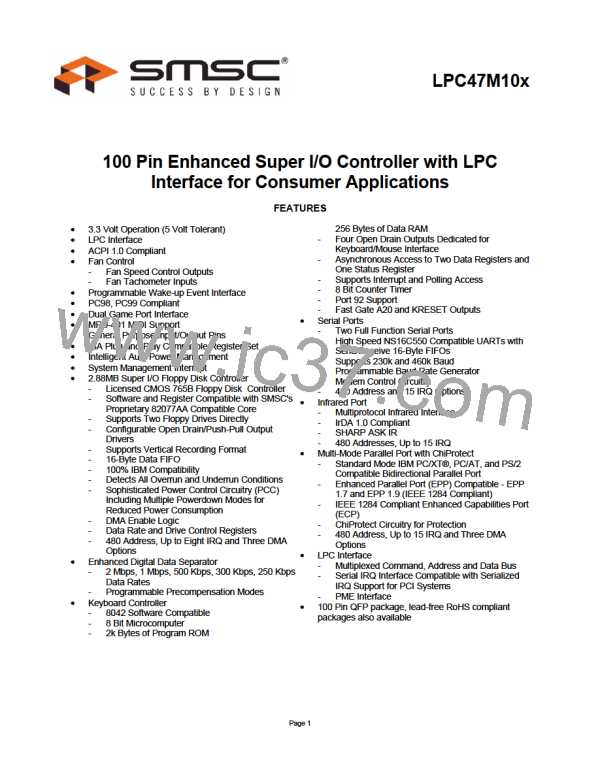GPIO PME and SMI Functionality
The following GPIOs are dedicated wakeup GPIOs with a status and enable bit in the PME status and enable
registers:
GP10-GP17
GP20-GP22, GP24-GP27
GP30-GP33
GP41, GP43
GP50-GP57
GP60, GP61
The following PME status and enable registers for these GPIOs:
PME_STS2 and PME_EN2 for GP10-GP17
PME_STS3 and PME_EN3 for GP20-GP22, GP24-GP27
PME_STS4 and PME_EN4 for GP30-GP33, GP41, GP43, GP60 and GP61
PME_STS5 and PME_EN5 for GP50-GP57
The following GPIOs can directly generate an SMI and have a status and enable bit in the SMI status and enable
registers.
GP20-GP22, GP24-GP26
GP30-GP33
GP41, GP42, GP43
GP54-GP57
GP60, GP61
The following SMI status and enable registers for these GPIOs:
SMI_STS3 and SMI_EN3 for GP20-GP22, GP24-GP26 and GP60
SMI_STS4 and SMI_EN4 for GP30-GP33, GP41, GP42, GP43 and GP61
SMI_STS5 and SMI_EN5 for GP54-GP57, FAN_TACH1 and FAN_TACH2.
The following GPIOs have “either edge triggered interrupt” (EETI) input capability. These GPIOs can generate a
PME and an SMI on both a high-to-low and a low-to-high edge on the GPIO pin. These GPIOs have a status bit in
the MSC_STS status register that is set on both edges. The corresponding bits in the PME and SMI status registers
are also set on both edges.
GP21, GP22
GP41, GP43
GP60, GP61
The following table summarizes the PME and SMI functionality for each GPIO. It also shows the Either Edge
Triggered Interrupt (EETI) input capability for the GPIOs and the power source for the buffer on the I/O pads.
BUFFER
GPIO
GP10-GP17
GP20-GP22, GP24-GP26
GP27
GP30, GP31
GP32, GP33
GP35
GP36, GP37
GP40
GP41
GP42
GP43
GP50-GP52
GP53
PME
Yes
Yes
Yes
Yes
Yes
No
No
No
SMI
No
EETI
POWER
VCC
VCC
VCC
VCC
VCC
VTR
VCC
VCC
VCC
VTR
VCC
VCC
VTR
VCC
VTR
NOTES
No
GP21, GP22
No
4
4
4
4
5
1
2
2
4
Yes
nIO_SMI
Yes
Yes
No
No
No
No
No
No
Yes
No
Yes
No
No
No
No
Yes
Yes
Yes
No
No
Yes
Yes
Yes
nIO_PME
Yes
4, 6
4
1, 5
4
Yes
Yes
Yes
Yes
GP54-GP57
GP60, GP61
No
Yes
3, 4
Note 1: GP35 and GP53 have the IRTX function and their output buffers are powered by VTR so that the pins are
always forced low when not used.
Page 106

 SMSC [ SMSC CORPORATION ]
SMSC [ SMSC CORPORATION ]